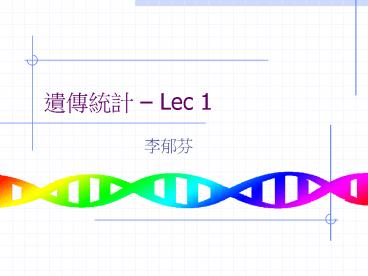Lec 1 PowerPoint PPT Presentation
1 / 34
Title: Lec 1
1
???? Lec 1
- ???
2
Molecular Genetics
- Genetic information
- Location
- Interpretation
- Translation
- Transmission of genetic information
- Variations in genetic information
3
Genetic information
- Chromosomes are found almost exclusively in
nucleus - Except red blood cells, all human cells have a
nucleus - DNA (deoxyribonucleic acid)
- carrier of the genetic information
- two strands (double helix)
4
Figure 12.2 Eukaryotic chomosomes
5
Figure 12.3 Chromosome duplication and
distribution during mitosis
6
(No Transcript)
7
(No Transcript)
8
Nitrogenous base, Nucleoside, and Deoxynucleoside
9
Nucleoside and Nucleotide
10
DNA Base Pairing
- Watson and Crick a complementary pairing, via
hydrogen bonding, of guanosine (G) with cytidine
(C) and adenosine (A) with thymidine (T).
11
Double Helix Structure
12
More about DNA
- Any two DNA fragments differ only w.r.t. the
order of their linear sequence of bases - the genetic information
- The primary structure of the DNA
- DNA length
- Basic unit is one nucleotide or one basepair (bp)
- The human DNA contains about 3.3 billion bp
- Nucleoside base distribution in DNA
13
RNA (Ribonucleic Acid)
- Much shorter than DNA
- One strand
- Bases A, C, G, U (uracil)
14
DNA and RNA
15
Human Chromosomes
- 23 chromosomes
- 22 autosomes (122 long -gtshort, but 21 is
the shortest) - 1 sex chromosomes X or Y
- Haploid 221
- Diploid a double set
16
Human Chromosomes
17
human karyotype
18
Human Chromosomes
- Two arms p (petit) and q (queue)
19
Protein
- Most functions are carried out by proteins
- Consist of polypeptides a linear sequence of
amino acids - three bases (a codon) code for one amino acid
- 4364 codons, but 20 amino acids
20
RNA Codons for Protein Synthesis
The third position often redundant
21
Central Dogma
22
Transcription and Translation
- A flash to explain the processes
23
Meiosis
- how genetic information can be transmittedf from
generation to teneration - a succession of events (two cell divisions)
- Prophase
- Metaphase
- Anaphase
- Telophase
- the number of possible combination in one gamete
from one parent is 223
24
Mitosis and Meiosis
- An excellent animated comparison of Mitosis and
Meiosis - Flash provided by NOVA online
- Homologous versus sister chromatids
- Recombination
25
Variations in Genetic Info
- Locus versus Allele
- at each locus an individual possesses two alleles
- Genotype versus Phenotype
- Homozygous versus Heterozygous
26
Variation in the DNA sequence
- Two main sources
- During cell division
- Insertions, deletions, inversions,
translocations, duplications
27
Alterations of chromosome structure
??
??
??
??
(also non-reciprocal translocation)
28
Variation in the DNA sequence
- Two main sources
- During cell division
- Insertions, deletions, inversions,
translocations, duplications - During DNA replication
- Mutation / Polymorphism
- Transitions (within purines and pyrimidines)
- Transversions (between purines and pyrimidines)
- Synonymous versus Nonsynonymous
- Frameshift mutation
29
Silent mutation Mis-sense Non-sense
30
Frameshift Mis-sense Frameshift Non-sense No
frameshift
31
Detection of Variations in the DNA sequence
- PCR (polymerase chain reaction)
- Amplification of DNA
- Each PCR cycle contains
- Denaturation high T
- Hybridization low T
- Elongation med T
- Sequencing
- Primers Probes
- Fluorescent dyes
32
High-throughput platforms
- working in single or low-plex mode
- SEQUENOM
- Matrix-assisted laser desorption ionisation
time-of-flight (MALDI-TOF) mass spectrometry - Pyro-sequencing
- Applied Biosystems' TaqMan technology
- multiplexed version of the oligoligation assay
(OLA) - Applied Biosystem's SNPlex technology
simultaneously detect 48 SNPs
33
Ultra High-throughput platforms
- Array-based SNP typing
- custom-designed arrays of smaller size
(1500-20,000 SNPs) - GoldenGate assay from Illumina
- MegAllele assay from ParAllele/Affymetrix.
- 100K 500K SNPs in a single experiment
- GeneChip microarrays from Affymetrix
- BeadChip arrays from Illumina
34
HOMEWORK1
- Group projects
- Transcription
- Translation
- Mitosis and Meiosis

